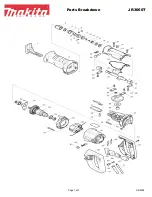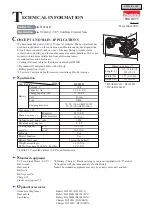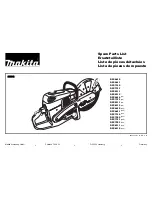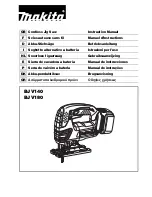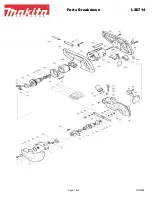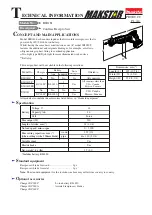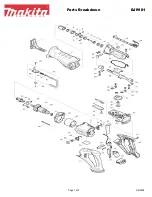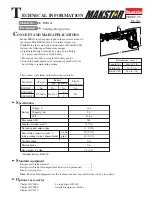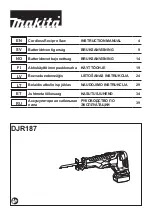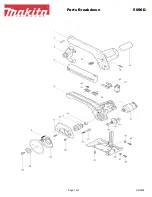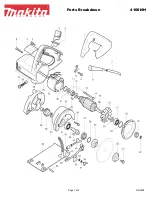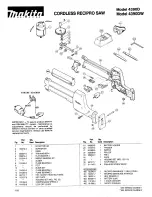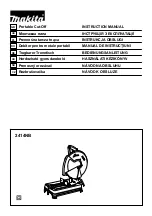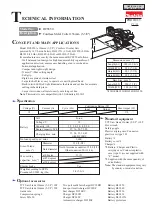
ENGLISH
22
wrench or a key left attached to a rotating
part of the power tool may result in personal
injury.
e)
Do not overreach. Keep proper
footing and balance at all times.
This
enables better control of the power tool in
unexpected situations.
f)
Dress properly. Do not wear loose
clothing or jewellery. Keep your hair,
clothing and gloves away from moving
parts.
Loose clothes, jewellery or long hair
can be caught in moving parts.
g)
If devices are provided for the connection
of dust extraction and collection facilities,
ensure these are connected and properly
used.
Use of dust collection can reduce
dust-related hazards.
4) POWER TOOL USE AND CARE
a)
Do not force the power tool. Use the
correct power tool for your application.
The correct power tool will do the job
better and safer at the rate for which it
was designed.
b)
Do not use the power tool if the switch
does not turn it on and off.
Any power
tool that cannot be controlled with the switch
is dangerous and must be repaired.
c)
Disconnect the plug from the power
source and/or the battery pack from
the power tool before making any
adjustments, changing accessories, or
storing power tools.
Such preventive safety
measures reduce the risk of starting the
power tool accidentally.
d)
Store idle power tools out of the reach
of children and do not allow persons
unfamiliar with the power tool or these
instructions to operate the power tool.
Power tools are dangerous in the hands of
untrained users.
e)
Maintain power tools. Check for
misalignment or binding of moving parts,
breakage of parts and any other condition
that may affect the power tool’s operation.
If damaged, have the power tool repaired
before use.
Many accidents are caused by
poorly maintained power tools.
f)
Keep cutting tools sharp and clean.
Properly maintained cutting tools with sharp
cutting edges are less likely to bind and are
easier to control.
g)
Use the power tool, accessories and
tool bits etc., in accordance with these
instructions taking into account the
working conditions and the work to
be performed.
Use of the power tool for
operations different from those intended
could result in a hazardous situation.
5) SERVICE
a)
Have your power tool serviced by a
qualified repair person using only identical
replacement parts.
This will ensure that the
safety of the power tool is maintained.
Additional Safety Instructions for
Reciprocating Saws
•
Hold power tool by insulated gripping
surfaces when performing an operation
where the cutting accessory may contact
hidden wiring or its own cord.
Cutting
accessory contacting a "live” wire will make
exposed metal parts of the power tool “live” and
could give the operator an electric shock.
• ALWAYS wear a dust mask.
Exposure to
dust particles can cause breathing difficulty and
possible injury.
•
NEVER
switch on the tool when the saw blade
is jammed in the workpiece or in contact with
the material.
• Keep hands away from moving parts.
Never
place your hands near the cutting area.
•
Use extra caution when cutting overhead
and pay particular attention to overhead
wires which may be hidden from view.
Anticipate the path of falling branches and
debris ahead of time.
•
Do not operate this tool for long periods of
time.
Vibration caused by the operating action
of this tool may cause permanent injury to
fingers, hands, and arms. Use gloves to provide
extra cushion, take frequent rest periods, and
limit daily time of use.
SWITCHING ON AND OFF
• After switching off, never attempt to stop the
saw blade with your fingers.
• Never put the saw down on a table or work
bench unless switched off. The saw blade will
keep running briefly after the tool has been
switched off.
WHEN SAWING
• When using saw blades specially designed for
cutting wood remove all nails and metal objects
from the workpiece before starting work.
• Wherever possible, use clamps and vices to
fasten the workpiece securely.
• Do not attempt to saw extremely small
workpieces.
• Do not bend too far forward. Make sure
that you always stand firmly, particularly on
scaffolding and ladders.
Summary of Contents for DWE357
Page 1: ...www eu DWE357 ...
Page 3: ...1 Figure 1 c Figure 2 Figure 3 Figure 4 e d c a b e f ...
Page 4: ...2 Figure 5 Figure 7 Figure 9 Figure 6 Figure 8 ...
Page 119: ...117 ...































